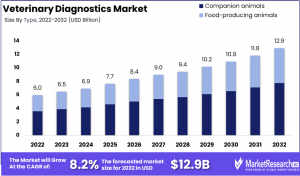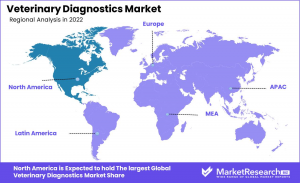Veterinary Diagnostics Market Set For Steady Growth, Expected To Reach USD 12.9 Billion By 2032
Global Veterinary Diagnostics Market size is expected to be worth around USD 12.9 Bn by 2032 from USD 6.5 Bn in 2023, growing at a CAGR of 8.2%
North America Is Expected To Dominate Due To Rising Healthcare Costs, An Increase In The Incidence Of Veterinary Diseases, And An Increase In Pet Ownership. ”
NEW YORK, NY, UNITED STATES, February 6, 2025 /EINPresswire.com/ -- Report Overview— Tajammul Pangarkar
Global Veterinary Diagnostics Market size is expected to be worth around USD 12.9 Bn by 2032 from USD 6.5 Bn in 2023, growing at a CAGR of 8.2% during the forecast period from 2023 to 2032.
The veterinary diagnostics industry is witnessing rapid advancements, enabling faster and more accurate disease detection in animals. Veterinary diagnostics include blood tests, imaging, molecular diagnostics, and point-of-care testing to diagnose and monitor various animal diseases. These technologies play a crucial role in companion animal care, livestock management, and zoonotic disease prevention.
The demand for advanced veterinary diagnostics is growing due to increasing pet ownership, livestock disease outbreaks, and the need for early disease detection. Innovations in PCR testing, immunoassays, and AI-powered diagnostic tools are improving veterinary healthcare by providing rapid and precise results. According to veterinary health reports, early disease detection reduces treatment costs by up to 50% and improves survival rates in animals.
Leading companies are investing in portable diagnostic devices and AI-driven analytics, making diagnostics more accessible for veterinarians and pet owners. The integration of digital pathology and telemedicine further enhances remote consultations and disease management.
Unlock Competitive Advantages With Our PDF Sample Report @ https://marketresearch.biz/report/veterinary-diagnostics-market/request-sample/
Key Takeaways
- Market Size: Global Veterinary Diagnostics Market size is expected to be worth around USD 12.9 Bn by 2032 from USD 6.5 Bn in 2023,
- Market Growth: The market growing at a CAGR of 8.2% during the forecast period from 2023 to 2032.
- Advanced Diagnostic Technologies: Innovations in PCR testing, immunoassays, and AI-powered diagnostics enhance accuracy and speed of disease detection in animals.
- Point-of-Care Testing: The growing adoption of portable diagnostic devices allows veterinarians to conduct on-site testing, reducing wait times for results.
- Companion Animal Demand: Increasing pet healthcare spending and awareness about preventive diagnostics are driving market growth, especially in developed regions.
- Livestock Health Management: Rapid disease detection in cattle, poultry, and swine helps prevent economic losses and zoonotic disease transmission.
- AI and Digital Pathology: AI-powered diagnostic imaging and digital pathology solutions are transforming remote veterinary consultations and disease management.
- Regional Dominance: North America and Europe lead the market, driven by strong veterinary infrastructure and high adoption of advanced diagnostics.
- Future Outlook: The market is expected to grow steadily, fueled by technological advancements, increased veterinary awareness, and rising animal healthcare investments.
How Artificial Intelligence (AI) is Transforming the Veterinary Diagnostics Market ?
•AI-Powered Imaging and Diagnostics: AI enhances X-ray, ultrasound, and MRI interpretations, improving early disease detection in animals. AI-based deep learning models can analyze medical images with higher precision than traditional methods, helping veterinarians identify fractures, tumors, and organ abnormalities faster.
•Automated Disease Detection: AI-driven machine learning algorithms analyze blood tests, microbiology data, and genetic markers to detect infectious diseases, metabolic disorders, and genetic conditions in animals. AI tools provide rapid and reliable test results, improving treatment planning.
•AI-Enabled Point-of-Care Testing: Portable AI-powered diagnostic devices allow veterinarians to conduct real-time testing in clinics or farms. These tools help detect conditions like canine parvovirus, feline leukemia, and livestock infections without needing lab facilities.
•Predictive Analytics for Disease Prevention: AI algorithms analyze big data from veterinary records, climate conditions, and livestock health trends to predict disease outbreaks. This enables early intervention, reducing the spread of zoonotic diseases and improving animal health management.
•AI-Driven Digital Pathology: AI automates pathology slide analysis, accelerating diagnoses of cancer, bacterial infections, and parasitic diseases. AI-powered pathology solutions enhance remote diagnostics and telemedicine capabilities in veterinary care.
Market Segments
Type
•Companion animals
•Food-producing animals.
End-User
•Veterinary hospitals & clinics
•Research institutions
•Reference laboratories
•Point-of-care testing/in-house testing
Product
•Instruments
•Consumables
•services
Food-producing animals
•Poultry
•Cattle
•Sheep & goat
•Pigs
•Other food-producing animals
Buy This Premium Research Report : https://marketresearch.biz/purchase-report/?report_id=26868
Market Dynamics
•Driver: The increasing prevalence of zoonotic diseases necessitates advanced veterinary diagnostics to ensure early detection and control. According to the Centers for Disease Control and Prevention (CDC), zoonotic diseases are caused by harmful germs like viruses, bacteria, parasites, and fungi that are spread between animals and people. Early and accurate diagnosis is crucial in managing these diseases, underscoring the importance of robust veterinary diagnostic capabilities.
•Trend: The integration of artificial intelligence (AI) into veterinary diagnostics is an emerging trend. AI enhances the capabilities of diagnostic tools, enabling more precise and efficient analysis of complex data. For instance, AI algorithms assist in interpreting imaging results, leading to quicker and more accurate diagnoses. The National Institutes of Health (NIH) highlights ongoing research in AI applications within veterinary diagnostics, indicating a shift towards more intelligent and automated systems.
•Restraint: Limited access to advanced diagnostic facilities in rural and underserved areas poses a significant restraint. The U.S. Department of Agriculture (USDA) notes that veterinary services in rural regions often face challenges such as inadequate infrastructure and a shortage of trained professionals. This disparity hinders the timely diagnosis and treatment of animal diseases, affecting both animal health and public safety.
•Opportunity: The growing emphasis on antimicrobial stewardship presents an opportunity for the veterinary diagnostics market. Accurate diagnostics are essential in guiding appropriate antimicrobial use, thereby combating resistance. The National Center for Biotechnology Information (NCBI) emphasizes that effective stewardship relies on precise diagnostic information to inform treatment decisions, highlighting the critical role of diagnostics in promoting responsible antimicrobial use.
Regional Analysis
North America is projected to lead the veterinary diagnostics market, driven by rising healthcare costs, an increasing prevalence of veterinary diseases, and a surge in pet ownership. The market expansion is fueled by key factors such as greater awareness of animal health, increased spending on pet care, and supportive government initiatives focused on animal welfare.
A major contributor to market growth is the rising expenditure on animal healthcare. Pet owners are prioritizing preventive care and advanced treatments, driving demand for improved veterinary diagnostics. Innovations such as molecular diagnostic testing, imaging, and rapid diagnostic techniques are revolutionizing disease detection in animals, enabling timely and accurate diagnoses and improving treatment success rates.
The incidence of veterinary diseases has also surged in North America. Conditions like rabies, Lyme disease, and heartworm infections are becoming more prevalent, necessitating enhanced diagnostic and testing services. To meet this demand, veterinary clinics and animal hospitals are investing in modern diagnostic tools to provide reliable and precise results. Another key driver is the rise in pet ownership. Over 67% of U.S. households own at least one pet, and this number continues to grow annually. As pet populations increase, demand for veterinary diagnostic services is expected to rise, further accelerating market growth.
Top Key Players
•ABAXIS Inc.
•Thermo Fisher Scientific Inc.
•Heska Corporation
•VCA Inc.
•Neogen Corporation
•Zoetis Inc.
•ID.Vet.
•IDEXX Laboratories Inc
•Mindray Medical International Ltd.
•Virbac
•GE Healthcare
•Agfa Healthcare
•Randox Laboratories Ltd.
•Agrolabo S.P.A
Emerging Trends in Veterinary Diagnostics
•Integration of Big Data Analytics: The application of big data analytics in veterinary diagnostics is enhancing disease surveillance and health management. By analyzing large datasets, veterinarians can identify health risks, monitor disease trends, and implement timely interventions to mitigate adverse health outcomes in animal populations.
•Advancements in Molecular Diagnostics: The adoption of molecular diagnostic techniques, such as genome sequencing, has revolutionized the detection of animal pathogens. These methods offer high sensitivity and specificity, enabling rapid and accurate identification of infectious agents, which is crucial for effective disease control and prevention.
•Emergence of Biomarkers: The development of new biomarkers is transforming veterinary practice by facilitating rapid disease diagnosis, effective health monitoring, and improved animal welfare. These molecular indicators are instrumental in early detection and management of various animal diseases.
Use Cases of Veterinary Diagnostics
•Early Detection of Infectious Diseases: Advanced diagnostic tools enable the timely identification of diseases such as canine parvovirus and feline leukemia. Early detection through diagnostics allows for prompt treatment, reducing mortality rates and preventing disease spread among animal populations.
•Monitoring of Zoonotic Diseases: Veterinary diagnostics play a crucial role in identifying diseases that can be transmitted from animals to humans, such as rabies and avian influenza. Accurate diagnostics are essential for monitoring these diseases, implementing control measures, and safeguarding public health.
•Support in Public Health Emergencies: During the COVID-19 pandemic, veterinary diagnostic laboratories contributed significantly by providing high-throughput testing capabilities. Their involvement in SARS-CoV-2 testing exemplifies the versatility of veterinary diagnostics in supporting public health initiatives.
Lawrence John
Prudour
+91 91308 55334
email us here
Legal Disclaimer:
EIN Presswire provides this news content "as is" without warranty of any kind. We do not accept any responsibility or liability for the accuracy, content, images, videos, licenses, completeness, legality, or reliability of the information contained in this article. If you have any complaints or copyright issues related to this article, kindly contact the author above.



